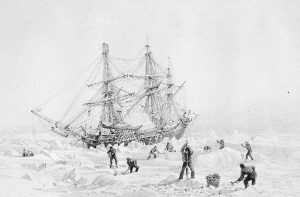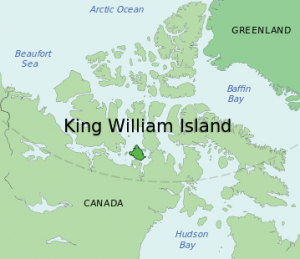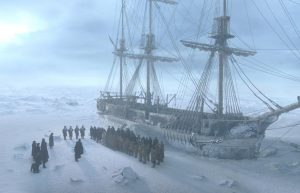 Modern day ships sailing the polar regions of our Earth have one distinct advantage over the much earlier counterparts…a radio. Radios wouldn’t be in place until 1899. The ships that sail these areas are trying to find new passages to cross the massive ice flows without having to sail far from their intended destinations in an effort to be in waters that are not frozen by the severe cold of the polar regions. When we think of ice, we rarely think of the shifting of the polar ice flows…or at least I didn’t really think of that. The changes in the day to day temperatures can create cracks in the ice, and the movement of the water below can either free a ship, or entrap it further, in an ever tightening squeeze hold that forces the crews to abandon the ship or risk being crushed to death when the ice moves again.
Modern day ships sailing the polar regions of our Earth have one distinct advantage over the much earlier counterparts…a radio. Radios wouldn’t be in place until 1899. The ships that sail these areas are trying to find new passages to cross the massive ice flows without having to sail far from their intended destinations in an effort to be in waters that are not frozen by the severe cold of the polar regions. When we think of ice, we rarely think of the shifting of the polar ice flows…or at least I didn’t really think of that. The changes in the day to day temperatures can create cracks in the ice, and the movement of the water below can either free a ship, or entrap it further, in an ever tightening squeeze hold that forces the crews to abandon the ship or risk being crushed to death when the ice moves again.
One such abandoned excursion was the case of the HMS Terror and the HMS Erebus. The ships were participating in Sir John Franklin’s ill-fated attempt to force the Northwest Passage in 1845, during which they were lost with all hands. Before leaving on the Franklin expedition, both Erebus and Terror underwent heavy modifications for the journey. They were both outfitted with steam engines, taken from former London and Greenwich Railway steam locomotives. The engines were rated at 25 horse power, and each could propel its ship at 4 knots. The pair of ships became the first Royal Navy ships to have steam-powered engines and screw propellers. The ships carried a twelve day supply of coal. Iron plating was added fore and aft on the ships’ hulls  to make them more resistant to pack ice, and their decks were cross-planked to distribute impact forces. Along with Erebus, Terror was stocked with supplies for their expedition, which included among other items: two tons of tobacco, 8,000 tins of preserves, and 2,000 of liquor. Terror’s library had 1,200 books, and the ship’s berths were heated by ducts that connected them to the stove.
to make them more resistant to pack ice, and their decks were cross-planked to distribute impact forces. Along with Erebus, Terror was stocked with supplies for their expedition, which included among other items: two tons of tobacco, 8,000 tins of preserves, and 2,000 of liquor. Terror’s library had 1,200 books, and the ship’s berths were heated by ducts that connected them to the stove.
Sir John Franklin was in command of the expedition into the Artic in HMS Erebus, and Captain Francis Crozier was in command of HMS Terror. The expedition was tasked with gathering magnetic data in the Canadian Arctic and to complete a crossing of the Northwest Passage, which had already been charted from both the east and west, but never entirely navigated. The expedition was planned to last three years. The expedition sailed from Greenhithe, Kent, on May 19, 1845, and the ships were last seen entering Baffin Bay in August 1845. When the ships did not return at the appointed time,a massive search effort began in 1848 and again in 1866 in the Arctic. Eventually, enough evidence was found to reveal the circumstances of the expedition’s fate. Both ships had become icebound and had to be abandoned by their crews. Sadly, all 129 crew members died of exposure and starvation while trying to trek overland to Fort Resolution, a Hudson’s Bay Company outpost 600 miles to the southwest. Subsequent expeditions up until the late 1980s, including autopsies of crew members, revealed that their canned rations may have been tainted by both lead and botulism. Oral reports by local Inuit that some of the crew members resorted to cannibalism were at least somewhat supported by forensic evidence of  cut marks on the skeletal remains of crew members found on King William Island during the late 20th century.
cut marks on the skeletal remains of crew members found on King William Island during the late 20th century.
While crew members had been found over the years, the ships were not found for 169 and 171 years respectively. In 2014, the wreck of HMS Erebus was discovered, and on September 12, 2016, the Arctic Research Foundation announced that the wreck of Terror had been found ironically in Nunavut’s Terror Bay, off the southwest coast of King William Island. The wreck was discovered 57 miles south of the location where the ship was reported abandoned, and some 31 miles from the wreck of HMS Erebus.


One Response to Ice